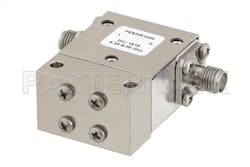What are RF Isolators and RF Circulators?
RF circulators are three port devices designed to provide isolation between transmit and receive signals for radar, actively electronically steered antenna (AESA) arrays, satellite communications, and telecommunications applications. An isolator is a modified circulator with one port terminated with a matched impedance. Circulators and isolators are typically used to protect sensitive receiver circuitry from high powered transmitter outputs, by separating the transmitter’s signals from the received signals at the input of the antenna. For radar and antenna array applications, this is especially critical, as the number of antennas is doubled if full-duplex operation of an antenna isn’t possible.
Most RF circulators are coaxial or waveguide packaged devices based on passive ferromagnetic technologies. These types of circulators typically provide very high isolation in their frequency range of operation. The magnetic field generated within the ferromagnetic circulator during operation “forces” the RF signals in each port to follow the rotation of the magnetic field and prevents signal leakage in the opposite direction. Compared to cavity duplexers used in base stations and in-building telecommunications installations, RF circulators are more compact, often lower cost, and provide enhanced isolation.
Circulators and isolators are used in applications from hundreds of megahertz to tens of gigahertz, and are mostly specified for operation in radar and communication bands. The frequency bandwidth of operation of a circulator is dictated by the geometry of the magnetic material used, the design of the transmission line, and the impedance matching network of the circulator. The type of ferrite and manufacturing techniques used will also influence the performance of a circulator.
Isolation, insertion loss, and bandwidth are the most critical performance parameters used to describe circulators and isolators. Many other factors may be important for a particular application, such as power handling, VSWR, interconnect technology, size, temperature range, and other environmental considerations. The power handling of a circulator is typically driven by the type of ferrite material, housing, and interconnect technology used. An isolator power rating may also be limited by the type of termination used in the 3rd port of the device.
An isolator can be made by terminating a circulator. However, manufactured isolators may have a much better matched port which enables enhanced bandwidth and isolation compared with a circulator with an off-the-shelf termination.
Though coaxial circulators and isolators are the most common, there are also drop-in and surface-mount technology (SMT) circulators and isolators. The size and interconnect with compact drop-in or SMT circulators and isolators limits the bandwidth, power, isolation, and insertion loss capabilities of these devices. Lastly, there are various techniques of creating integrated circuit compatible circulator and isolator devices being researched. Some of these techniques use switching and unique material properties to create the circulation effect.
To learn more of Pasternack’s Circulator and Isolators, visit: https://www.pasternack.com/nsearch.aspx?Category=Circulators^Isolators&sort=y&view_type=grid.
If you have specific questions about RF Circulators and Isolators, you can reach Pasternack’s RF Experts here: USA & Canada (866) 727-8376 International +1 (949) 261-1920.
